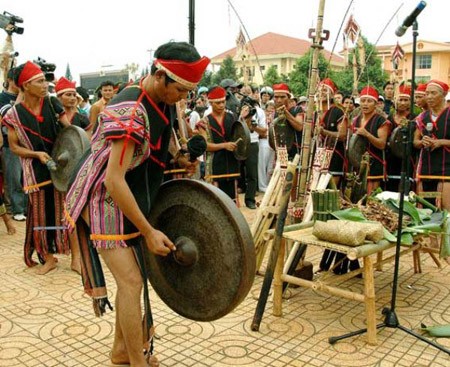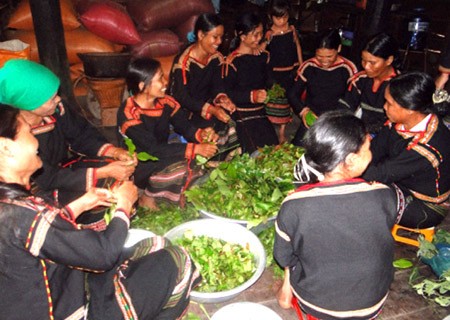(VOVworld) – The M’Nong have maintained many unique customs and cultural values. The wedding ceremony is an important community event which embeds with the typical identities of the Central Highlanders.
.jpg)
A ritual in a wedding ceremony of the M'Nong Preh
(photo: phunuvietkieu.vn) |
Festivals to pray for rain, bumper crops, new rice, and dual singing events are opportunities for M’Nong boys and girls to make friends and date. When a boy likes a girl, he tells his family to ask a maternal uncle or a male matchmaker to come to the girl’s family to make a marriage proposal. As one of the 5 ethnic minority groups in Vietnam following matriarchy, the M’Nong women are more active in their marriage. Nguyen Thi Ngoc, a researcher of ethnic culture at the Dac Lac Museum of Ethnic Minority Groups, says the M’Nong think that a good son-in-law will bring prosperity to the family. “
In the M’Nong matriarchy, the bridegroom will live with his wife’s family. So the bridegroom’s family will ask for a wedding present. The bride’s family has to prepare the offering which normally includes a buffalo and some items.”

Gong performance in the wedding ceremony |
The boy’s family comes to the girl’s family to make a marriage proposal. The ceremony takes place from 8 to 9 p.m when it’s dark because if the girl’s family refuses the proposal, the boy’s family will not lose face to the villagers. The boy’s family brings a large and flat basket, a bowl of rice, a rooster, a necklace, and a dress. The matchmaker will make the proposal on behalf of the boy. Before taking the offering, the girl’s parents ask their daughter if she agrees or not. Then the two families check their family annals carefully, if they are not connected they will be allowed to marry. The girl’s family gives the boy’s family a big jar of wine to accept the proposal. They come to discuss details of the next engagement ceremony.
On the engagement day, the boy’s family sends a prestigious, old man and some strong, young men to bring the offering including two rattan tubes containing fermented bamboo shoots, a necklace, and a bronze bracelet to the girl’s family. The matchmaker wears the necklace on the girl and the bronze bracelet on the boy which means the two families acknowledge them as husband and wife. The bride’s family burns incense on the altar to inform their ancestors of the marriage. They drink wine together and discuss the wedding ceremony about one week later. The bride’s family prepares 100 baskets of rice, 100 jars of wine, and a buffalo for the wedding party. They will also prepare 50 bowls, 50 cups, and 50 necklaces as gifts for the groom’s parents and relatives. A Ma Phong, a M’Nong man, says: “
In the past, a wedding didn’t cost much but it took place in many days. The bride’s family prepares buffalos, pigs, and chickens to treat both families. The villagers dance, sing, and play gongs to pray for the couple in two or three days.”
To begin the wedding ceremony, the bride’s family gives a bowl of rice to every person in the groom’s family as a wish for prosperity. The matchmaker takes the couple to the main pillar in the house where witnesses of the two families tie a scarf around the pillar. The couple hold the scarf which means they are tied forever. The matchmaker tells the couple of their responsibilities to their parents and families. Then they drink wine together.
 |
| Villagers come to help prepare the wedding party |
Wedding guests bring wine, sticky rice, and food to contribute to the party. A ceremony to welcome the groom will take place on the next day. After the wedding ceremony, the couple has to stay in the bride’s and avoid meeting strangers. They will then stay in the groom’s family the following week before living with the bride’s family for their whole life.